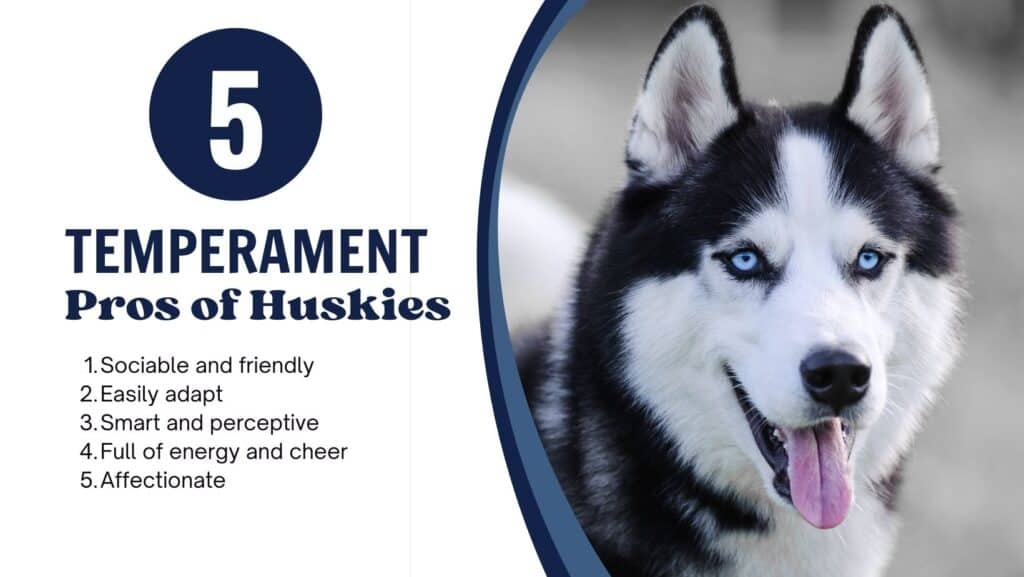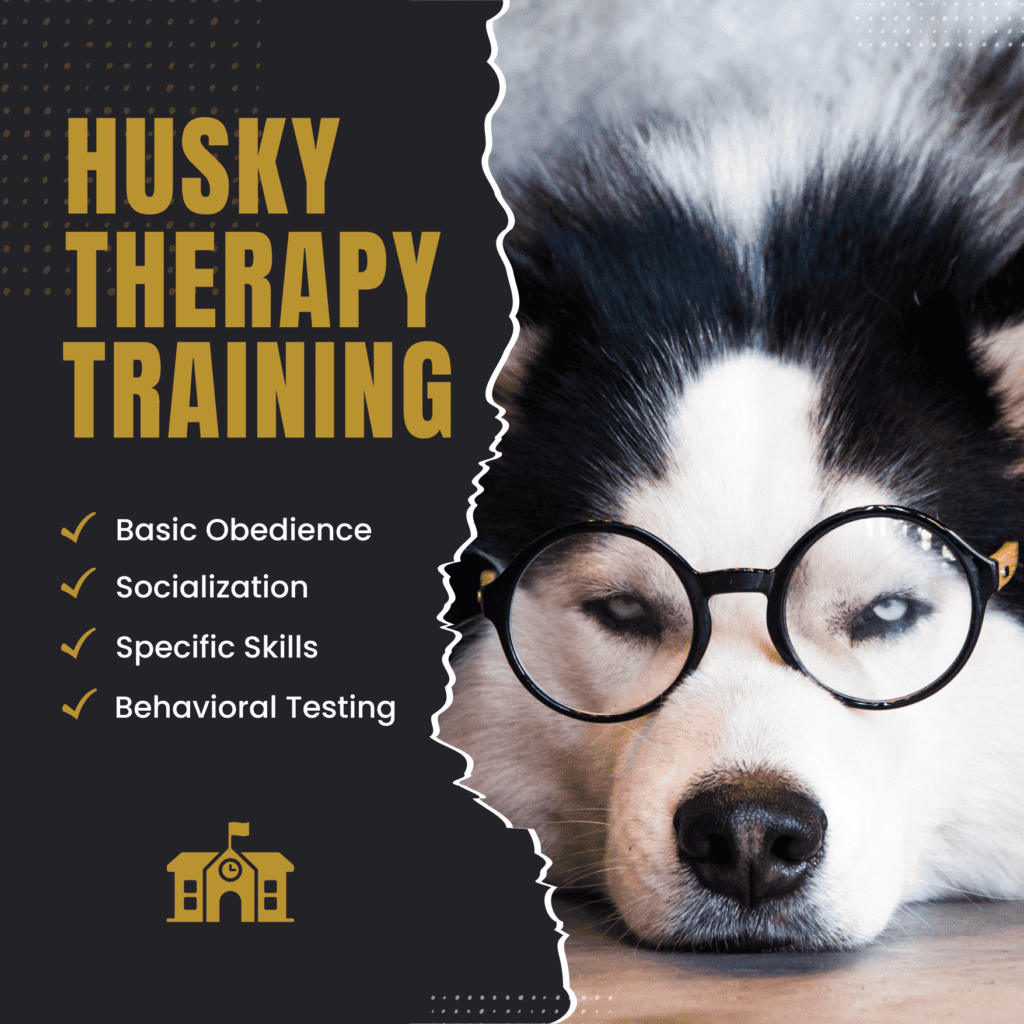We have ads and affiliate links sprinkled around like dog treats at a training session. As an Amazon Associate we earn from qualifying purchases. If you click and make a purchase, we earn a few kibbles to keep this dog park of a website running. So, thanks for tossing us a bone.
Are Huskies good therapy dogs? This intriguing question often arises among dog lovers and those in search of a therapeutic companion.
Known for their stunning looks and dynamic energy, Huskies occupy a special place in the world of dogs. But their suitability as therapy dogs is a topic ripe for exploration.
Let’s start by understanding what makes an ideal therapy dog. These dogs typically showcase a calm and loving nature, offering comfort and support in various therapeutic environments.
Now, with Huskies, known for their unique traits and personalities, it’s important to examine how well they fit into this role.
Understanding the Job to Answer Are Huskies Good Therapy Dogs

When exploring if Huskies are good therapy dogs, it’s essential to first grasp what therapy dogs do and the qualities they should possess. This understanding lays the groundwork for assessing Huskies in this role.
What Makes a Therapy Dog?
Therapy dogs are more than just pets. They serve a special purpose. They provide comfort, emotional support, and even physical health benefits to individuals in settings like hospitals, schools, and nursing homes.
The interaction with a therapy dog can reduce stress, alleviate anxiety, and bring joy to people facing various challenges.
Key Qualities of Effective Therapy Dogs
- Calmness: They remain relaxed in diverse environments.
- Affectionate Nature: They show warmth and comfort to all.
- Trainability: They learn and follow commands effectively.
- Sociability: They interact well with strangers and other animals.
- Gentle Demeanor: They exhibit patience and gentleness, especially in stressful situations.
These qualities are crucial for any dog to succeed in therapy roles. They ensure that the dog can handle the unique demands of therapeutic settings.
Benefits of Therapy Dogs
- Emotional Support: They offer unconditional love, helping to ease loneliness and depression.
- Stress Reduction: Their presence can lower blood pressure and reduce stress hormones.
- Social Interaction: They encourage communication and socialization in group settings.
Understanding these aspects of therapy dogs is vital. It helps us better evaluate Huskies and their potential as therapeutic companions.
Don’t miss our post, Do Huskies Make Good Service Dogs? Investigating the Real Truth
Are Huskies Good Therapy Dogs: Evaluating Their Suitability as Therapy Dogs
To assess whether Huskies make good therapy dogs, it’s crucial to understand their breed-specific traits, shaped by their historical background and general characteristics.
Historical Background and Its Influence
Huskies have their roots in the cold regions of Siberia, where they were bred by the Chukchi people primarily as sled dogs. This historical role required them to be highly cooperative, enduring, and resilient, traits that could potentially translate well into therapy work.
Their history of working closely with humans highlights their potential for strong human-dog bonds, a key aspect of effective therapy dogs.
General Characteristics: Physical and Temperamental
Physical Attributes: Huskies are medium-sized with a thick double coat, suited for harsh climates. Their friendly facial expressions and striking eyes can be comforting, attributes that may positively influence their interaction in therapy settings.
Temperament: The energetic, playful, and incredibly friendly nature of Huskies is a double-edged sword. While their sociability and friendliness are assets in therapeutic interactions, their high energy levels and independence might pose challenges in controlled environments where calmness is crucial.
Addressing Common Misconceptions
- Perceived Aggressiveness: Despite some misconceptions, Huskies are not inherently aggressive. Their social and affable nature can be an asset in therapy settings, encouraging positive interactions.
- Family Compatibility: Sometimes seen as less ideal for families, Huskies can actually integrate well into family environments, indicating their potential to adapt to various human interactions in therapy scenarios.
- Trainability Concerns: While Huskies may show some independence and stubbornness, with the right approach, they are trainable. This adaptability is vital in a therapy dog, as they need to respond well to training to behave appropriately in therapeutic environments.
Their historical adaptability, physical and temperamental traits, and sociability provide insights into their possible effectiveness in therapy roles.
Are Huskies Good Therapy Dogs: Temperament Essentials

Understanding the temperament of Huskies is essential in evaluating their potential as therapy dogs. Here, we’ll look at the pros and cons of their temperament traits, highlighting five key points in each category.
5 Pros of Husky Temperament for Therapy Work
- Sociable and Friendly: Huskies are known for their approachable and friendly nature, making them great at interacting positively with a variety of individuals.
- Resilient and Adaptable: Their history as sled dogs has equipped Huskies with a resilience and adaptability that can be valuable in varied therapy environments.
- Intelligent and Perceptive: Huskies are smart and can be quite perceptive to human emotions, which is a beneficial trait in understanding and responding to the needs of those they’re assisting.
- Energetic and Uplifting: Their high energy can bring a sense of vitality and cheerfulness to therapy sessions, especially beneficial in motivational or active therapy settings.
- Affectionate Bonding: Huskies often form strong, affectionate bonds with their handlers and those they interact with, fostering a sense of trust and comfort.
5 Cons of Husky Temperament for Therapy Work
- High Energy Levels: While their energy can be a pro, it can also be a challenge in settings that require calm and gentle interactions, such as with elderly individuals or in hospitals.
- Independence in Training: Their independent nature might make training more challenging, requiring more time and patience to achieve therapy dog standards.
- Need for Regular Exercise: Huskies require a significant amount of physical activity, which might be demanding in the context of a therapy dog’s lifestyle.
- Potential for Destructive Behavior: If not properly exercised or mentally stimulated, Huskies can exhibit destructive behaviors, which can be problematic in therapy settings.
- Vocal Nature: Huskies are known for being vocal, which includes howling and barking. This trait might be disruptive in certain therapeutic environments where quiet is necessary.
While Huskies have many positive traits that could make them suitable for therapy work, their high energy levels, training requirements, and vocal nature present specific challenges.
These factors are important to consider when comparing Huskies to other breeds typically used in therapy roles.
Comparisons with Other Popular Therapy Dog Breeds
When considering Huskies for therapy work, it’s helpful to compare them with other breeds commonly used in therapy settings.
Labrador Retrievers
- Temperament: Known for their consistent calmness, friendliness, and eagerness to please.
- Training: Generally easier to train than Huskies due to their strong desire to please.
- Energy Levels: Labradors are energetic but typically more manageable than Huskies.
- Suitability: Labs are often seen as the gold standard in therapy work due to their stable temperament and adaptability.
Golden Retrievers
- Temperament: Characterized by their gentle, patient, and affectionate nature.
- Training: Like Labradors, Golden Retrievers are receptive to training and exhibit a strong willingness to learn.
- Energy Levels: They possess a balanced energy level, suitable for various therapy environments.
- Suitability: Golden Retrievers are highly valued in therapy due to their dependable and gentle demeanor.
Cavalier King Charles Spaniels
- Temperament: Known for their gentle, affectionate, and adaptable nature.
- Training: They are relatively easy to train and are responsive to gentle guidance.
- Energy Levels: Lower energy levels compared to Huskies, making them well-suited for calm therapy settings.
- Suitability: Their small size and calm demeanor make them excellent for therapy work, especially in settings that require a less intimidating presence.
German Shepherds
- Temperament: Intelligent, loyal, and protective, but can be aloof with strangers.
- Training: Highly trainable due to their intelligence and loyalty, though they require consistent and firm training.
- Energy Levels: Active and need regular exercise, but their energy is usually more focused than that of Huskies.
- Suitability: German Shepherds are often used in more active therapy roles and with handlers who can meet their training and exercise needs.
While Huskies have unique traits that could be beneficial in therapy settings, breeds like Labrador Retrievers, Golden Retrievers, Cavalier King Charles Spaniels, and German Shepherds each bring their own set of qualities that often make them more commonly chosen for therapy work.
Their temperament, ease of training, and energy levels are key factors that generally align more closely with the requirements of a therapy dog compared to the more independent and high-energy Husky.
Are Huskies Good Therapy Dogs? What are Their Training Capabilities?

To further understand the suitability of Huskies as therapy dogs, it’s crucial to evaluate their training capabilities.
This includes an analysis of the general training requirements for therapy dogs and how the Huskies’ unique learning style fits into this framework, along with the challenges and strategies for training them for therapy work.
Training Requirements for Therapy Dogs
Therapy dogs need to exhibit a high level of obedience, calmness, and sociability. Key training requirements include:
- Basic Obedience: Mastery of basic commands like sit, stay, come, and heel.
- Socialization: Exposure to various environments, people, and situations to ensure they remain calm and adaptable.
- Specific Skills: Training to perform tasks relevant to therapy settings, such as gently interacting with people of all ages and with different abilities.
- Behavioral Testing: Passing behavioral assessments to ensure they can handle unexpected situations without aggression or fear.
Huskies’ Learning Style and Trainability
- Intelligence and Independence: Huskies are intelligent but have an independent streak, which can make them less motivated by traditional obedience training methods.
- Positive Reinforcement: They respond well to positive reinforcement techniques, such as treats and praise.
- Consistency and Patience: Training a Husky requires consistency and patience, given their tendency for independent decision-making.
Challenges and Tips for Training Huskies for Therapy Work
High Energy Levels
Challenge: Huskies’ high energy can make maintaining focus in training sessions difficult.
Tip: Integrating physical exercise into training can help manage their energy and improve focus.
Prone to Distraction
Challenge: Their tendency to get easily distracted, especially in stimulating environments, can hinder training progress.
Tip: Gradually increase the level of distractions during training to better acclimate them to varied environments.
Perceived Stubbornness
Challenge: Huskies’ independent nature can sometimes come across as stubbornness in training contexts.
Tip: Employ engaging and varied training methods to maintain their interest and motivation.
Consistency in Training
Challenge: Maintaining consistent training can be a challenge due to their independent traits.
Tip: Establish a regular training routine with consistent commands and rewards to foster learning and obedience.
Although Huskies have the intelligence suitable for therapy work, their distinct training needs pose specific challenges. Adapting training methods to their energetic and independent nature is crucial for preparing them for therapy roles.
An understanding of their learning style is key to making the training process both effective and enjoyable.
Are Huskies Good Therapy Dogs: Identifying Suitable Types of Roles
While Huskies present unique challenges as therapy dogs, certain types of therapy work are particularly well-suited to their specific traits and abilities. Understanding these roles can help in effectively utilizing Huskies in therapeutic settings.
Active Therapy Environments
Huskies thrive in active environments due to their high energy and endurance. Settings that require movement, such as therapy programs involving physical activities or outdoor therapy sessions, can be ideal.
Their playful and energetic nature can be particularly beneficial in motivating and engaging individuals in physical therapy or activities designed to improve mobility and fitness.
Emotional Support and Stress Relief
The friendly and sociable nature of Huskies makes them suitable for roles that focus on providing emotional support and stress relief.
Their presence can be comforting, especially in settings like universities or workplaces where they can help reduce stress and anxiety during high-pressure periods.
Therapy Work with Children and Adolescents
Huskies can be excellent in therapeutic settings involving children and adolescents. Their playful demeanor and approachable appearance can make interactions more engaging for young individuals.
This can be particularly effective in educational settings or programs aimed at improving social skills, emotional development, or in providing comfort in pediatric hospitals.
Outdoor and Adventure Therapy

Huskies, with their historical background in sled pulling and resilience in outdoor conditions, are well-suited for adventure therapy programs. These programs often involve outdoor activities where the Huskies’ love for exploration and activities in natural settings can be a great asset.
Their presence can enhance the therapeutic experience in wilderness therapy or adventure-based counseling.
Community and Group Therapy Settings
In community or group therapy settings, Huskies’ sociable nature can facilitate group interactions and create a sense of camaraderie among participants. Their ability to bond with multiple individuals can help in building a supportive and interactive environment.
Even though Huskies may not fit the traditional mold of therapy dogs suited for quiet and controlled environments, their unique characteristics make them well-suited for more active and dynamic therapy roles.
These include settings that require physical activity, provide emotional support, involve work with children, or take place in outdoor and community-based environments.
Understanding and leveraging these strengths is key to effectively integrating Huskies into suitable types of therapy work.
Are Huskies Good Therapy Dogs? Prep Work
Training a Husky for therapy work involves a structured approach, understanding of certification and legal requirements, and ensuring the dog’s health and well-being.
Here’s a step-by-step guide to prepare a Husky for a role in therapy work.
Step-by-Step Guide on Training a Husky for Therapy Roles
- Assess Suitability: Evaluate the Husky’s temperament and health to ensure they are a good candidate for therapy work.
- Basic Obedience Training: Begin with basic obedience commands like sit, stay, come, and heel. This is foundational for all future therapy training.
- Socialization: Expose the Husky to various environments, people, and situations to build confidence and adaptability.
- Advanced Training: Once basic obedience is mastered, introduce more advanced commands and behaviors specific to therapy work.
- Desensitization: Gradually expose the Husky to environments similar to therapy settings (e.g., hospitals, schools) to acclimate them.
- Mock Therapy Sessions: Practice therapy sessions in controlled environments to simulate real-life scenarios.
- Regular Assessment and Feedback: Continuously assess the Husky’s progress and adjust training methods as needed.
Certification and Legal Requirements
- Therapy Dog Certification: Obtain certification from a recognized therapy dog organization. This often involves passing a test that assesses the dog’s behavior, obedience, and interaction with people.
- Health Clearances: Ensure the Husky has up-to-date vaccinations and health clearances, as required by most organizations and therapy facilities.
- Legal Compliance: Familiarize yourself with any local laws or regulations related to therapy dogs, including any specific requirements for public access.
Maintaining the Health and Well-Being of a Husky in Therapy Work
- Regular Exercise: Ensure the Husky gets sufficient physical activity to manage their high energy levels.
- Mental Stimulation: Provide mental stimulation through interactive toys, puzzles, and ongoing training to keep them engaged.
- Health Checks: Regular veterinary check-ups are essential to maintain their physical health and ability to perform therapy work.
- Emotional Well-Being: Monitor the Husky’s emotional state, providing rest and downtime, especially after intensive therapy sessions.
- Balanced Diet: A nutritious diet is crucial for maintaining the Husky’s health and energy levels.
Preparing a Husky for therapy work is a comprehensive process that requires dedicated training, adherence to certification and legal standards, and a strong commitment to the dog’s overall health and well-being.
With the right preparation and care, Huskies can become valuable companions in various therapeutic settings.
Considerations Before Choosing a Husky as a Therapy Dog
Selecting a Husky as a therapy dog involves careful consideration of several factors. Understanding the lifestyle and environment requirements, the commitment of time and resources, and recognizing when a Husky might not be suitable for therapy work are critical steps in making an informed decision.
Are Huskies Good Therapy Dogs? Lifestyle and Environment Considerations
- Space and Exercise Needs: Huskies require ample space and significant daily exercise. Prospective owners should assess if their living environment can accommodate these needs, especially if the dog will be working in therapy settings.
- Climate Adaptability: Given their thick coat, Huskies are well-suited for cooler climates. In warmer regions, special attention should be given to keeping them comfortable and preventing overheating.
- Family Dynamics: Huskies are generally sociable with both humans and other pets, but it’s important to consider the dynamics of your household. Their high energy and playfulness should be compatible with all family members.
Commitment of Time and Resources
- Training Time: Huskies require consistent and ongoing training, both for basic obedience and specific therapy skills. This commitment extends beyond initial training, as their skills and behaviors need to be regularly reinforced.
- Financial Investment: The cost of training, certification, health care, and maintenance for a therapy dog can be significant. Potential owners should be prepared for this financial commitment.
- Availability: Regular availability is needed not just for training, but also for therapy sessions and engagements. Owners need to dedicate time for these activities.
Recognizing if a Husky is Not Suitable for Therapy Work
- Temperament Mismatch: If a Husky shows signs of excessive hyperactivity, aggression, or extreme shyness, they might not be well-suited for therapy work.
- Health Issues: Chronic health problems can hinder a Husky’s ability to perform therapy work effectively and comfortably.
- Inability to Adapt to Training: Some Huskies may not respond well to the training required for therapy dogs, showing signs of stress or disinterest in the activities.
It’s crucial to weigh these considerations carefully before deciding to train a Husky as a therapy dog. The decision should be based on a realistic assessment of the Husky’s suitability to the therapy dog role and the owner’s ability to meet the dog’s needs and the demands of therapy work.
Making an informed choice ensures the well-being of both the dog and the individuals they will assist.
Are Huskies Good Therapy Dogs? 10 Questions to Determine if Your Husky is a Fit

Determining if a Husky is suitable for therapy work involves a thorough assessment of various traits and behaviors.
Below are ten key questions, each followed by a detailed explanation, to help you evaluate if your Husky is a good candidate for a therapy dog role.
1. Does Your Husky Show Consistent Friendliness?
Consistent friendliness is crucial for therapy dogs. Evaluate whether your Husky is reliably gentle and amicable around new people. Therapy dogs need to interact positively with strangers, showing no signs of aggression or excessive shyness.
2. How Does Your Husky React to Unfamiliar Situations?
Observe your Husky’s behavior in new environments. A suitable therapy dog remains calm and adaptable when facing unfamiliar settings, showing neither fear nor overexcitement.
This trait is vital as therapy dogs often visit various locations.
3. Is Your Husky Comfortable with Varied Handling?
In therapy settings, a dog will experience different types of handling by various people. Assess how your Husky reacts to being touched by strangers. A suitable therapy dog should be comfortable and non-reactive to handling.
4. Can Your Husky Stay Calm in Busy Environments?
A key characteristic of therapy dogs is the ability to maintain composure in bustling or noisy environments. Evaluate if your Husky can remain relaxed and attentive amidst distractions, a common scenario in many therapy settings.
5. How Does Your Husky Handle Sudden or Loud Noises?
Sudden and loud noises are typical in therapy environments. Notice if your Husky remains calm or exhibits anxiety when exposed to unexpected sounds.
A therapy dog should not be easily startled or disturbed by such noises.
6. Is Your Husky Responsive to Training Commands?
Therapy dogs need to be obedient and responsive. Assess how well your Husky follows basic commands. This obedience is essential for safe and effective therapy work.
7. Does Your Husky Have a Suitable Energy Level?
Consider whether your Husky’s energy level is appropriate for the therapy environment you have in mind. High energy might be beneficial in some settings, but a calmer demeanor is necessary in others.
8. Is Your Husky in Good Health and Well-Groomed?
Therapy dogs should be in good health and well-groomed. This ensures that they are presentable and hygienic for interactions, making the experience pleasant and safe for everyone involved.
9. Do You Have the Time and Resources for Training and Maintenance?
Reflect on whether you can provide the necessary time and resources for your Husky’s training and care. Consistent training and proper maintenance are crucial for a therapy dog’s success and well-being.
10. Does Your Husky Show Signs of Stress in Social Situations?
Observe if your Husky seems stressed or anxious in social settings. A therapy dog should be relaxed and comfortable in various social interactions, as stress can negatively impact their ability to perform therapy work effectively.
By answering these questions, you can gain a better understanding of your Husky’s potential as a therapy dog. It’s important to remember that suitability for therapy work varies among individual dogs, and a Husky’s unique characteristics should be carefully considered.
Final Thoughts to Are Huskies Good Therapy Dogs
In conclusion, determining whether Huskies are good therapy dogs requires a comprehensive evaluation of their temperament, training capabilities, and individual characteristics. While Huskies possess many qualities that can be beneficial in therapy settings, such as sociability, intelligence, and resilience, their high energy levels and independent nature present unique challenges.
Prospective therapy dog handlers should consider these factors, alongside their own ability to meet the training and care needs of a Husky.
Ultimately, the suitability of a Husky as a therapy dog depends on the individual dog’s traits, the specific therapy environment, and the dedication of the handler to provide the necessary training and support.
